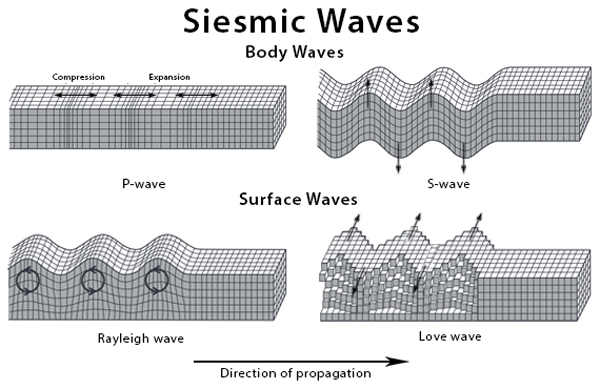Seismic Waves
Definition: What are Seismic Waves?
Seismic waves are energy waves that are generated by an earthquake or explosion and propagate within the Earth or on its surface. Earthquakes occur when there is a movement of Earth’s tectonic plates. Seismic waves are studied by seismologists using an instrument called seismograph, which records the frequency and amplitude of the waves to study Earth’s subsurface activities. The time taken by seismic waves to arrive at seismic observatories allows seismologists to locate the precise location of an earthquake. The results can provide a snapshot of the Earth’s internal structure and help them to locate and understand fault planes and the stresses and strains acting on them.
Types of Seismic Waves
There are two different types of seismic waves: body waves and surface waves.

Sources: Analog.com
Body Waves
As the name suggests, body waves travel through the interior of the Earth and have a frequency higher than the surface waves. Body waves are divided into P or primary and S or secondary waves.
P-waves: Also called pressure waves, can propagate in solid and liquid materials. They travel very rapidly and are the first to reach the seismograph. The motion of a P-wave is like that of a slinky. They propagate through a material by alternately compressing and expanding the medium. The particles’ motion is parallel to the direction of wave propagation, similar to a longitudinal wave.
S-waves: Also called shear waves, they can only propagate in a rigid, solid material through the vibration of particles in a direction perpendicular to the propagation (like a transverse wave). Hence, they cannot propagate through a liquid. By studying the trajectories of S-waves, seismologists could prove that the Earth has a liquid outer core.
Surface Waves
Surface waves are similar to transverse waves but travel along the boundary between the Earth’s surface and air, i.e., through the crust. They have a lower frequency than body waves. They can be easily distinguished and are responsible for the damage and destruction caused by earthquakes. The particles in a surface wave move in a circular or elliptical motion. The intensity of surface waves diminishes as they go deeper from the surface. Two common types of surface waves are the Rayleigh wave and the Love wave.
Rayleigh Waves: Named after British physicist Lord Rayleigh, who predicted their existence, the motion of Rayleigh waves is a combination of longitudinal, compressional, and dilational. As a result, the particles move elliptically in a vertical plane. These waves are dispersive, and the amplitudes generally decrease exponentially with depth in the Earth.
Love Waves: Named after British mathematician A. E. H. Love, the particles of Love waves jerk back and forth perpendicular to the direction of wave propagation, similar to S-waves. The motion of particles of the Love wave makes a horizontal line perpendicular to the direction of propagation. The energy of Love waves spreads from the source in two directions rather than in three. The amplitude often decreases rapidly with depth. Love waves travel faster than Rayleigh waves.
FAQs
Ans. P-waves travel most rapidly.
Ans. Surface waves are the most dangerous as they travel through the surface of the Earth.
Ans. Body waves travel through the interior of the Earth. In contrast, surface waves propagate only at the interface between two different media.
Ans. Seismic waves are used to study earthquakes and to explore deep underground for reservoirs of oil and natural gas.
Ans. Seismic waves are generated by movements of the Earth’s tectonic plates (earthquakes) and may also be caused by explosions.
Ans. Seismic waves and sound waves are mechanical waves and require a medium for propagation.
Ans. Seismic waves travel through the Earth’s interior and surface.
Ans. A seismograph can record seismic waves.
Article was last reviewed on Friday, April 4, 2025







